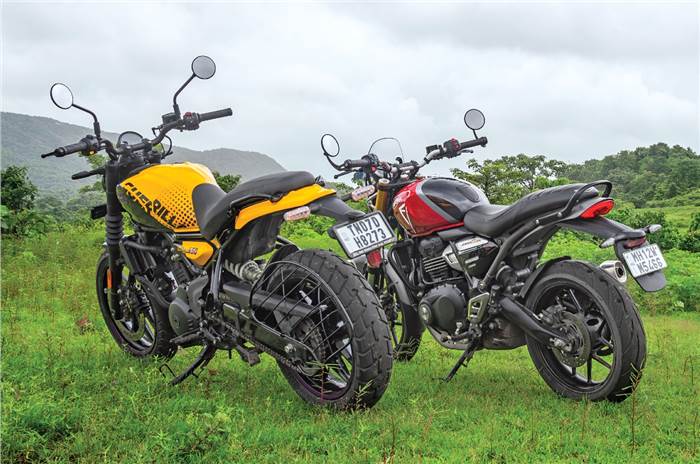Two very old British names face off with two thoroughly modern locally made bikes and we discover they’re more different than you might think.
There are many, many similarities between the two motorcycles that we have here today. For example, they both wear very old British badges but are actually thoroughly modern, made-in-India machines. Both produce exactly 40 horsepower from their liquid-cooled single-cylinder engines, and both have a starting price of under Rs 2.4 lakh.
Having ridden them intensively for a few days, I can tell you that there’s no simple answer as to which is better because both have many appealing pros as well as a few significant cons.
The first impression
Starting with the pros, design is a big one on the Triumph, and it has the best attention to detail of any made-in-India motorcycle, including the new-age Royal Enfield seen here. There’s only one downside that becomes apparent when parked next to most other 350-400cc bikes – it doesn’t really have that much presence. The Speed 400 is not a small bike, and even tall riders will fit on it well, but it does look and feel a little too slender.

The Enfield has a more quirky design in comparison, which will be more polarizing, but there’s no doubt that it has more presence with its fat tyres, Himalayan-style rear panels and wider-looking fuel tank. That last element is ironic given that it actually has a smaller fuel capacity of 11 liters compared to 13 on the Speed.
The Guerrilla’s rear with that fat exposed tire looks nicer than the rather practical rear of the Triumph, but the trade-off is that it flings more road muck onto the rider in wet conditions. At 185kg, the RE is heavier than the Triumph (176kg), but its 780mm tall seat is the lowest in the segment, while the Speed 400’s is just 10mm higher.
On the move
Both have comfortable riding positions, but the Guerrilla’s feels a little more engaged with a wider, higher handlebar and higher-set footpegs. I find the Guerrilla’s position to be nicer, but the Triumph’s seat is more comfortable over longer durations.
Both also take different approaches to comfort in their suspension setups. The Guerrilla is noticeably stiffer, but thankfully, it isn’t harsh like the Hunter. It actually deals with bad roads quite well. It always feels firm but never uncomfortable, and it absorbs bumps without pitching you out of the seat. The Speed is softer, and this is nice at slower speeds and on smooth surfaces. However, when compared with the Guerrilla, it quickly gets bouncy over less-than-ideal surfaces.

Guerrilla’s telescopic fork works well.
The Guerrilla’s suspension and general chassis setup are designed to be fun on a winding road. Despite carrying nine extra kilos, it feels lighter-steering, more agile and far more enthusiastic about diving into a set of corners. The Speed is very competent, but while it comes across as being able to do it, the Guerrilla was built to enjoy doing it. The same goes for the brakes, with the Triumph’s being strong and reassuring, but the RE’s are better, both in terms of feel and performance.
Change of pace
The tides turn when it comes to the engine. On paper, both make 40hp and the Enfield – with its 54cc advantage – produces a little more torque at slightly lower revs. In reality, both perform quite differently, and in many ways, the Triumph’s engine is better. For one, it’s more tractable in the city, and you can hold a gear higher than the RE without protest. It also has a lighter clutch and, coupled with its slim proportions, it is the nicer city bike. The Speed is also smoother on the highway, and while the vibrations do build up from 120kph, you’ll start to feel them from 100kph on the Guerrilla.

Looks good, but rev counter a bit hard to read.
Then there’s the fact that it’s also a little more fuel efficient than the Royal Enfield, both in the city and out on the highway, and it’ll have better highway range thanks to the larger fuel tank. As for actual performance, the tested numbers are almost identical, with the Enfield a little faster in acceleration, while the Triumph had a tiny advantage in roll-on test figures. It was very close, but the Guerrilla was tested in damp conditions, which could make a small difference.
Where the Enfield motor claws back some points is in sound and character. The Sherpa 450 engine is the more flawed motor here but also the more engaging one. It produces a nicer intake sound and has a more revvy, fun-to-ride feeling. In fact, its response can be surprisingly eager, especially when you shift from first to second gear and cross the 3,000rpm mark. For the few folks who won’t like this, there’s the option of changing to Eco mode, which significantly dumbs down the performance.
what you get
Before we wrap up, let’s just talk about features, and once again, there’s a bit of give and take. The Speed 400 gets a simpler analogue-digital display, but you do get the USD fork, traction control and an engine immobiliser. The Enfield gives you a simpler telescopic fork, but you get a center stand, two engine power modes and the option of the TFT display from the Himalayan.

Classy TFT screen on top two Guerrilla variants.
As for quality, some Triumph owners have complained about rusty bolts in a few areas and heavy condensation in the indicators – both were visible on our bike. Our bike also sometimes took up to five cranks to start up.
The Guerrilla is based on the Himalayan platform, which has its fair share of issues as well, the most infamous being the chassis failure, which Royal Enfield says was due to incorrectly installed aftermarket crash guards. It also has the same fiddly toggle button that has recently completely failed on our long-term Himalayan. Clearly, both manufacturers need to iron out some issues in these brand-new platforms.

The USD fork adds to the Speed’s visual appeal.
At the end of it all, I don’t think there is a clear winner here. It boils down to which plus points are more important to you and which negatives you are more willing to live with. For example, the Triumph is the more grown-up and sophisticated motorcycle here, and it has the more desirable badge on its fuel tank. It also has a smoother engine and is the nicer bike to commute on.
The RE counters with a higher fun factor and better suspension comfort, and it looks and feels like a more comprehensive motorcycle. I’d like both bikes to have been better in certain areas, but I find myself slightly inclined towards the Guerrilla. I like my motorcycles to look and feel special, and they have to be special in the way they ride. The Guerrilla ticks what are the most important boxes for me, but that doesn’t have to be the case with you.
Also See: RE Guerrilla 450 vs Triumph Speed 400 comparison video

Thank you for taking the time to read this article! I hope you found the information insightful and helpful. If you enjoyed this type of content, please consider subscribing to our newsletter or joining our community. We’d love to have you! Feel free to share this article with your friends and family, who might also find it interesting.

Kanishk Singh has always had a keen interest in fast-paced cars. For the past three years, he has been writing about automobiles, but his fascination with cars dates back even further. He thoroughly enjoys learning about their features and expressing his thoughts through his writing. Kanishk also has a profound interest in the stock market, shares, and business strategies. He possesses a wealth of knowledge on these subjects and consistently writes articles on them. Currently, he is working as a writer for Lattestnews24, specifically focusing on the Automobile, Finance, and Business categories. His well-crafted words are highly appreciated by the readers, as they find them both informative and creative.
